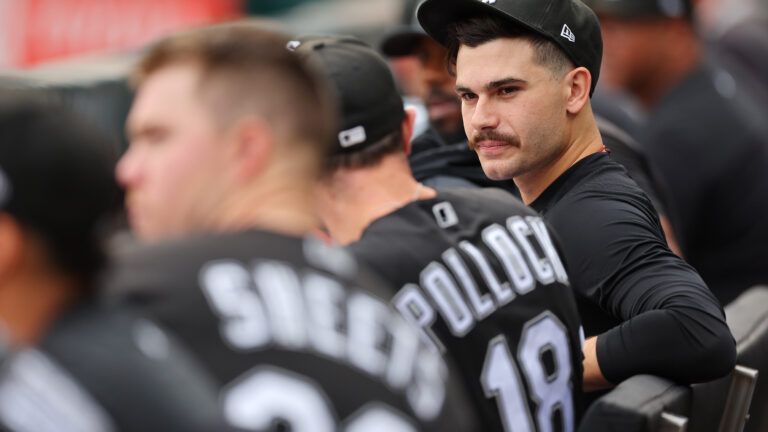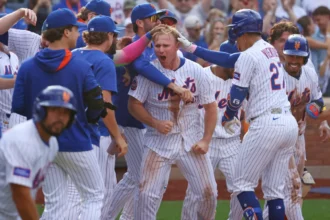The San Diego Padres find themselves in a challenging position as they navigate the fiercely competitive National League West. Their primary obstacle is the Los Angeles Dodgers, a franchise that has set an exceptionally high standard over the past decade. The Dodgers are not just a dominant team in terms of wins they have built a roster that is deep, balanced, and increasingly difficult for any competitor to surpass. Year after year, the Dodgers seem to find ways to improve, whether through strategic free-agent acquisitions, internal player development, or shrewd trades, making the Padres’ climb even steeper. For the Padres, it isn’t simply a matter of catching up; it’s about matching a team that has consistently established itself among the league’s elite, both in performance and in depth.
Compounding the Padres’ predicament is the looming departure of their ace, Dylan Cease, who is expected to enter free agency this coming winter. Cease has become one of baseball’s premier pitchers, recognized not only for his strikeout ability but also for his durability and consistency over multiple seasons. For San Diego, retaining Cease would represent a significant financial commitment, and it appears increasingly unlikely that the team has the payroll flexibility to offer him a contract large enough to keep him in town. This scenario opens the door for some of baseball’s wealthier franchises to enter a bidding war for his services, a situation that could dramatically alter the landscape of the upcoming offseason.

Among the potential suitors, the Boston Red Sox stand out as a team particularly well-positioned to pursue Cease. According to Bleacher Report’s Kerry Miller, Cease could command a staggering six-year deal worth approximately $168 million if he lands in Boston. Such a contract would place Cease among the highest-paid pitchers in the game, reflecting not only his accomplishments but also his projected value over the coming seasons. Miller highlighted the exceptional company Cease would join, pointing out that he has achieved something extremely rare: accumulating at least five seasons with 210 or more strikeouts before turning 30. In the last 40 years, the only pitchers to accomplish that feat include Clayton Kershaw, Félix Hernández, Pedro Martínez, Chris Sale, Roger Clemens, and now Dylan Cease. This milestone underscores both his consistency and his potential to remain an elite strikeout pitcher for many years to come.
Even with a somewhat down year Cease posted a 4.55 ERA in his most recent season his ability to dominate hitters and generate swings-and-misses keeps him in the upper echelon of pitching talent. Strikeouts, after all, are among the most predictive and valuable metrics for evaluating a pitcher’s impact, and Cease excels in this area. Pairing him with someone like Garrett Crochet, who led Major League Baseball with 255 strikeouts last season, could form one of the most fearsome pitching duos in recent memory. Miller even suggested that a rotation featuring Cease and Crochet could evoke memories of the early 2000s Arizona Diamondbacks, when Randy Johnson and Curt Schilling dominated in tandem. Such a combination would not just be impressive on paper; it could genuinely transform the Red Sox’s rotation into one of the most intimidating in baseball, particularly at a ballpark like Fenway Park, where generating strikeouts is crucial in suppressing opposing offenses.

However, while Boston represents a promising destination for Cease, there are practical challenges associated with pursuing a pitcher of his caliber. Signing him to a massive six-year, $168 million contract would likely constrain the Red Sox’s ability to invest elsewhere, particularly in their lineup. The financial implications of such a deal could limit the team’s flexibility to acquire complementary offensive talent, which remains a crucial component for sustained success. Baseball, after all, is a balancing act: elite pitching can carry a team far, but without a robust lineup to support it, even the best rotations can fall short of championship expectations. Therefore, Boston would need to weigh the benefits of adding Cease against the opportunity cost of potentially weakening other areas of the roster.
Despite these potential drawbacks, the upside of adding Cease is undeniable. The Red Sox have made it clear that pitching remains a pressing need, a gap that has only grown more evident with each passing season. While Cease may have experienced a relative decline in his most recent campaign, his overall skill set, experience, and strikeout ability would still represent a substantial upgrade for any team. Fenway Park, with its unique dimensions and hitter-friendly quirks, presents a challenging environment for pitchers, but Cease’s talent for generating swings-and-misses plays particularly well in such a setting. His ability to miss bats consistently can mitigate some of the park’s offensive advantages, making him an especially valuable asset for a team looking to shore up its pitching staff.

From the Padres’ perspective, the potential loss of Cease underscores the delicate nature of competing in a hyper-competitive division. San Diego has built a talented roster in recent years, featuring a blend of high-upside young players and established stars. Yet, the constraints of payroll management and the broader financial landscape mean that even top-tier talents like Cease may be out of reach. When an elite pitcher reaches free agency, teams with deeper pockets naturally have an advantage, often leaving mid-market or smaller-market teams in a difficult position. For San Diego, the challenge lies not only in replacing Cease on the field but also in maintaining competitiveness within a division dominated by a consistently superior Dodgers team.
Cease’s projected value also highlights broader trends in Major League Baseball’s free-agent market. High-strikeout pitchers under 30 are among the most sought-after commodities in the game, and teams are increasingly willing to make long-term financial commitments to secure such talent. Cease represents the archetype of this modern valuation: young, durable, capable of missing bats at an elite level, and with a proven track record of high strikeout totals. While traditional metrics like ERA provide some insight, the market increasingly favors underlying performance indicators such as strikeouts per nine innings and FIP (Fielding Independent Pitching), which better capture a pitcher’s true effectiveness. In this context, Cease is not just a solid free-agent acquisition; he is a potential cornerstone for a rotation for years to come.

For Boston, the decision to pursue Cease may also signal a strategic pivot toward emphasizing pitching depth over immediate offensive firepower. While a large contract would limit flexibility elsewhere, the Red Sox could justify the move as an investment in stability and long-term competitiveness. With Cease and Crochet anchoring the rotation, the team would gain a formidable top-end foundation, potentially enabling them to compete with powerhouse offenses across the American League. Moreover, a dominant rotation can serve as a catalyst for player development and roster flexibility: with fewer innings requiring management from the bullpen and a reliable top-of-the-rotation starter, other pitchers in the system can be nurtured more effectively, ultimately strengthening the team in the long run.
Meanwhile, other teams in the market will undoubtedly take notice of Cease’s availability. In a landscape where elite arms are scarce, the potential bidding war could drive the price well beyond even the projected $168 million figure, particularly if multiple high-profile franchises view Cease as a must-have addition. The Padres may find themselves in a situation where their former ace is being courted by some of the wealthiest teams in baseball, a testament both to Cease’s talent and to the competitive imbalance that sometimes defines free agency. For San Diego, the key will be mitigating the impact of his departure, whether through internal development, trades, or strategic free-agent signings.

Ultimately, the story of Dylan Cease reflects the intersection of talent, timing, and market dynamics in modern Major League Baseball. He represents an elite pitcher entering the prime of his career, with a skill set that commands attention from the league’s most ambitious franchises. Whether it is the Boston Red Sox, or another team with the financial means to secure his services, Cease is poised to make a significant impact wherever he lands. For the Padres, losing him would be a setback, but it also highlights the importance of building a balanced roster capable of competing in one of the toughest divisions in baseball.
Cease’s potential signing in Boston could become one of the defining stories of the offseason. Pairing him with Crochet would give the Red Sox arguably the most intimidating strikeout duo in the league, evoking comparisons to some of the best rotations of the modern era. Even with the financial trade-offs, such an addition would likely shift the balance of power in the American League, giving Boston a legitimate chance to contend at the highest level. The duo’s ability to neutralize opposing hitters in Fenway Park would be particularly significant, allowing the team to maintain competitiveness against powerhouse lineups while giving the offense time to find consistency. While the price tag is substantial, the strategic value of acquiring a pitcher of Cease’s caliber cannot be overstated.
In conclusion, the Padres’ situation exemplifies the challenges mid-market teams face in retaining elite talent in a competitive division. Dylan Cease’s expected free agency underscores the tension between payroll limitations and the realities of modern baseball economics. Meanwhile, the Boston Red Sox emerge as a logical suitor, with the potential to transform their rotation and make a serious push in the standings. Cease’s elite strikeout ability, age, and durability make him one of the most coveted pitchers on the market, and his potential pairing with Garrett Crochet could rival some of the most memorable rotations in recent history. While the financial commitment is significant, the upside of adding Cease to Boston’s roster is enormous, offering the team a chance to address a long-standing pitching need and reshape its competitive trajectory for years to come.





